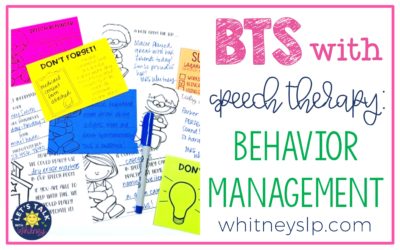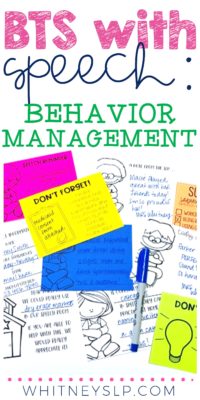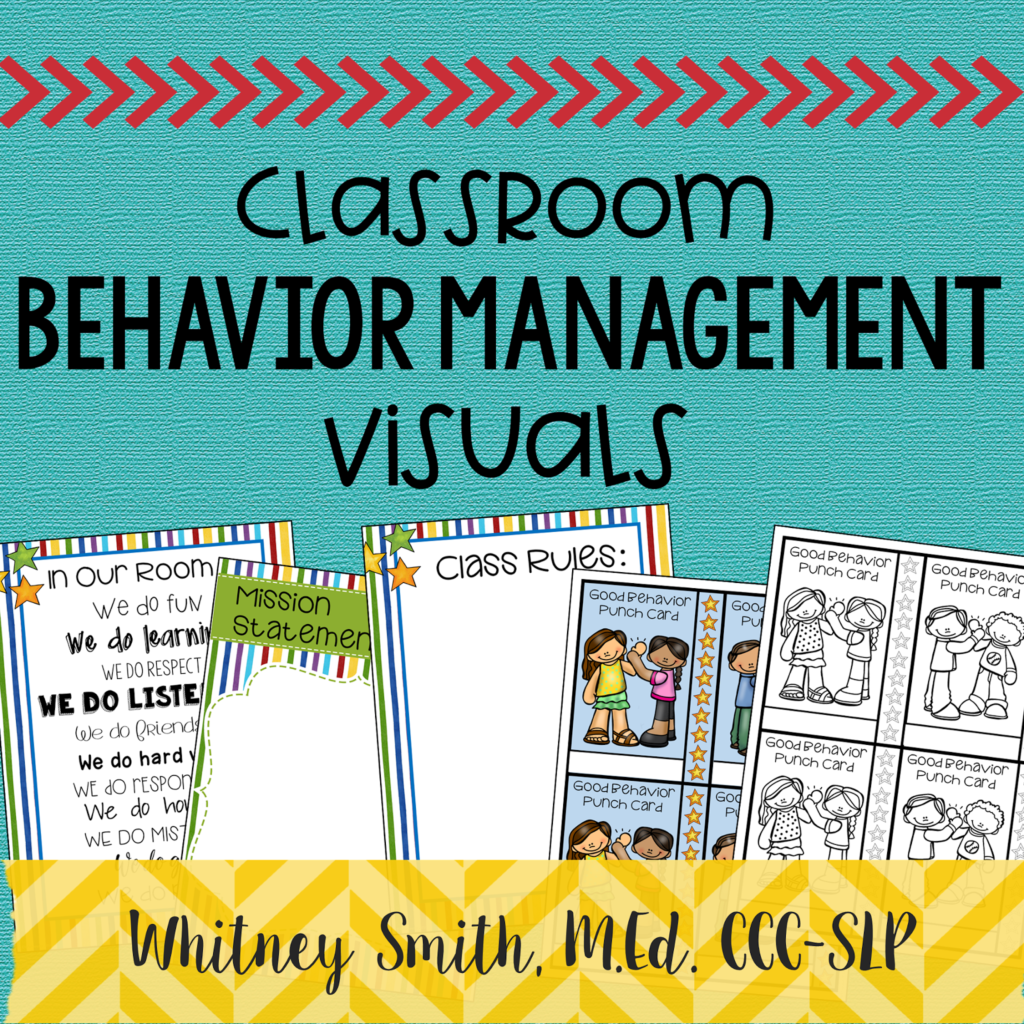Welcome to day three of my Back to School with Speech Therapy series. Each day you’ll receive a few tips on how I survive that first week back as I plan for students. Today, I’m focusing on Back to School with Speech Therapy: Behavior Management.
Starting the year off right…
Starting the year establishing rituals, routines, and clear-cut expectations for your precious students can make a big difference in setting the stage for the entire school year.

When people who are not in education ask me about my job, they are surprised to hear that so much of my job relates to behavior management. This is especially the case if you are like me and have a caseload made up predominantly of children on the Autism Spectrum.
Not all behavior is “bad.”
A lot of what I do is rewarding positive behavior. In addition, we also use interventions and behavior management systems to extinct other behaviors (finger biting, head banging, tantrums, etc. due to lack of communication skills). Though sometimes negative reinforcement is necessary (mostly by parents at home), I most often use positive reinforcement. Depending on the age level, we have different expectations. However, my colleagues will tell you that I don’t let much slip by me in the “behavior department.” I’m a firm believer that kids will rise to whatever expectations we set for them, so I set very high expectations when it comes to behavior.
Don’t Let Go of the Rope:
One of the areas I am asked about most from parents is behavior management. Though it is typical that kids act differently for other adults than they do for their own parents, I often have to remind parents that clear expectations and consistency are the most important things. Often, when kids know that there will be a consequence for all actions (whether good or bad), they will adapt.
I was raised on a Black Angus cattle farm. I grew up showing pigs and cows. When breaking a show heifer, it was imperative that no matter how hard they pulled in the opposite direction, you never, ever, let go of the rope. Once the heifer gets away that first time, she knows she can do it again, and boy will she try! I use this analogy to make this point: When setting consequences, kids wait for you to let go of the rope. And once you do, they will try their hardest to get you to do it again and again.
*Please note* this is not always the case with all children. It is crucial for you to identify the underlying cause of the behavior, whether it be avoidance, escape, attention, etc. Once you understand the antecedent, you can then form a plan for shaping the problem behaviors into something more acceptable.
Incorporating a Mission Statement:
In my classroom, my personal teaching mission statement is posted on the wall. In addition, the kids have their own personal mission statements (see Day 1 for the Student Folders Download). We also have our classroom rules posted as well. The first few weeks of school, we go over these daily. Throughout the school year, we go back and review as needed. This way, the kids know what I expect of them. They can’t ever say “I didn’t know!” The first few weeks of school, we spend the majority of our time on the 3 R’s: Rituals, Routines, and Rapport.
You can download a FREE AND EDITABLE mission statement and classroom rules posters (along with an “I Our Room…” poster and color and black and white good behavior punch cards by clicking the link below:
It’s Important to Note…
I feel like I should also add in here that I love my babies dearly. We have a great rapport. I joke around with them, love on them, and make it an important priority to point out good behavior when I see it. I sent positive notes home regularly. You can actually see the kids swell with pride when their name is called out for doing something good. I have such a good relationship with my kids that I very rarely have to discipline. They respect me, and they know I respect them. With this kind of relationship, they want to make good choices.
Our school is a PBIS School, and we have school-wide expectations that are posted and enforced no matter where the students are in the school. Our school also has a positive behavior reward system in place for encouraging expected behaviors when we see them. This has helped not only our school’s behavior as a whole, but also the overall culture and environment of our school.
For the Little Ones:
Probably the grades that require behavior management the most are Pre-K and Kindergarten. It’s not their fault. They are wired to move, move, and move! Instead of stopping instruction over and over to redirect behavior, I have a visual to remind the little ones of what is expected. These visuals are available in my TpT Store. Feel free to use it however it works best for you. We use the 3-strikes-you’re-out system. Each student has a chart. When I see someone not following the rules, I quietly place an “x” in whichever box the child is not doing. When they get 3 x’es, they lose their sticker. Since this is very visual, the little ones can actually see (and count) their warnings. And boy, they hate to lose their sticker!
One More Thing…
I wanted to add one more thing for those of you who work with students on the Autism Spectrum, or any other disability for that matter. Obviously, our expectations and the way we communicate those expectations are set according to the students’ ability to understand. However, it is my personal belief that kids with disabilities can learn expectations and follow rules just like kids without disabilities.
While there are some behaviors that we attribute to certain disabilities (such as acting out when schedules change for kids with Autism), it is our job to put interventions in place and teach the students that while we understand why they are upset, there are certain behaviors that are unacceptable. Instead, we should give them the resources they need to learn appropriate behaviors instead. By establishing clear expectations, rituals, and routines up front, and maintaining a good rapport with your students, you’ll be ahead of the game with behavior management, guaranteeing you more time for teaching.
How do you use behavior management in your job? Parents-how do you use behavior management at home? I hope the third day of the series, Back to School with Speech Therapy: Behavior Management was beneficial for you and that you’ll be back to join us for tomorrow’s post on Team Work!


















I just found your blog through Pinterest, I love the name – I made a Let's Talk sign for my room earlier this summer. Thanks for the post on behavior management. That's an area I struggle with.
Oh, How Pintearesting!
Thanks so much, Laura! I'm so glad you found it helpful. Thanks for sharing your blog name, too! -Whitney 🙂
I like your behavior checklist whitney! I may steal it 🙂
Steal Away!
I love the visuals for behavior for the littles! I will definitely be using this this year! 🙂 thank you!
Thanks so much, Courtney! 🙂